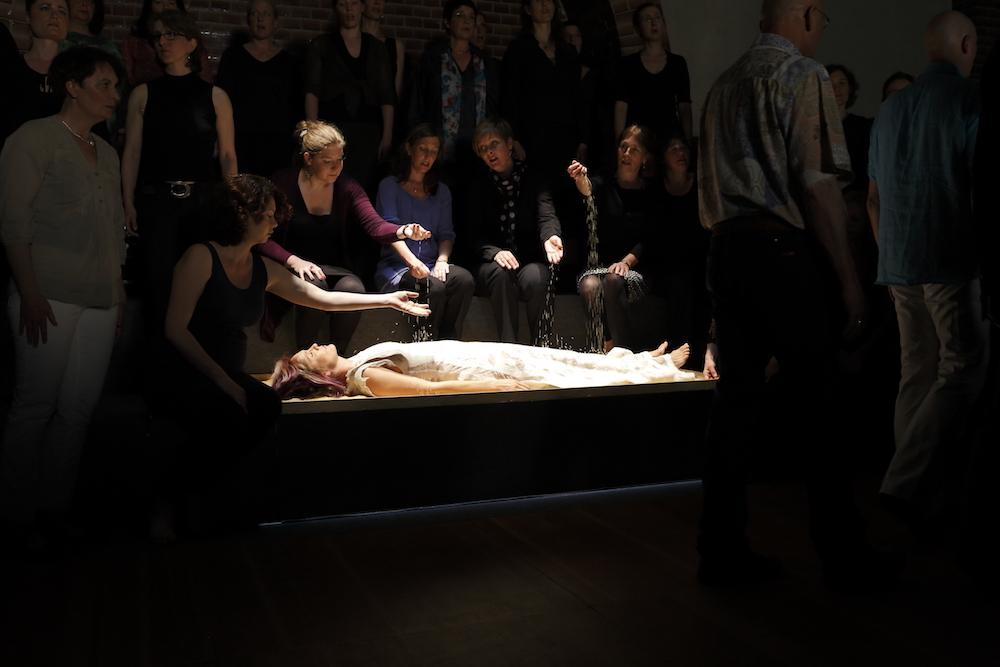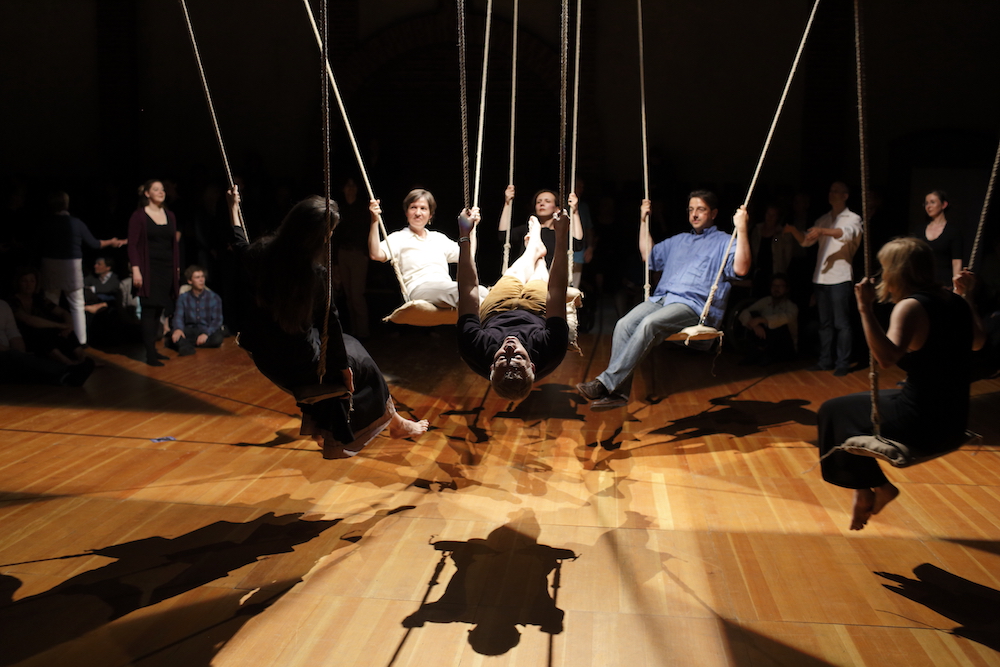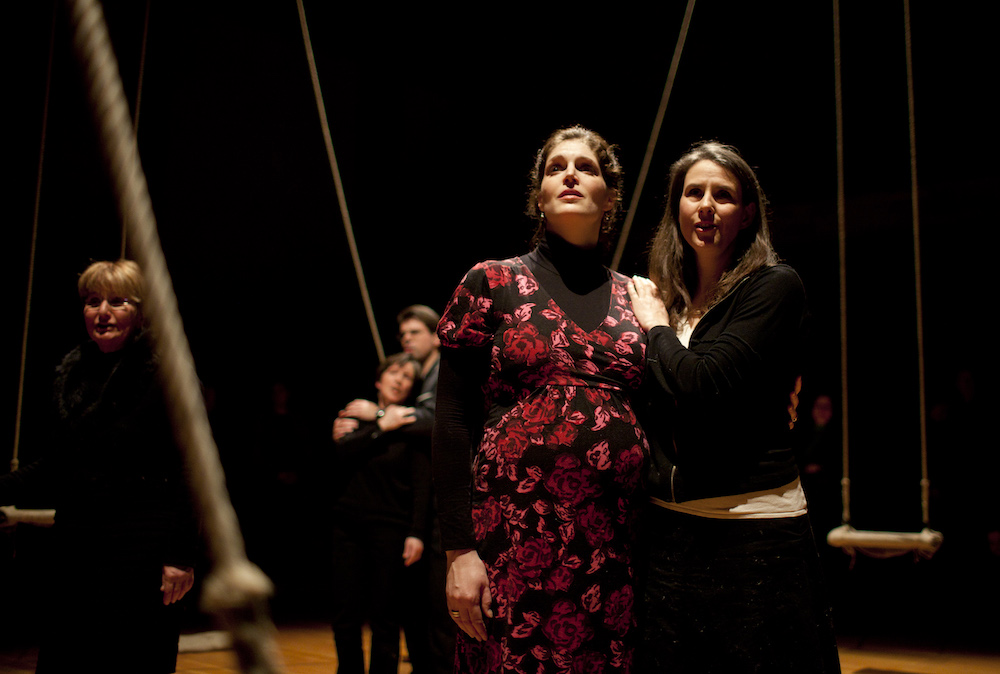March 14, 2018
Ridley Centre, Adelaide Showground
The beauty of Human Requiem is that, as it promises, it is not a concert. Audience and performers share the same space, breathe the same air, in an experience which is music, theatre and dance all in one. As reinvented by director Jochen Sandig, Brahms’ A German Requiem explores themes of death and resurrection, sorrow and joy, in a confronting, poignant and wholly beautiful way.
 Human Requiem. Photo © Matthias Heyde
Human Requiem. Photo © Matthias Heyde
There was a subtle ritualistic feel to the set, established from the very beginning. Before entering the performance space, every audience member had to take off their shoes and, as if passing into another world, must leave bags and belongings behind. The performance space at the Adelaide Showground’s Ridley Centre was a large room, empty except for the crowd, and lined with soft boards on which bare feet made about as much noise as a ghost.
As the lights dimmed and the audience hushed, the first notes flowed out of the twilight: the gossamer tones of a piano, placed at the edge of the space and played throughout with sensitivity and colour by Philip Mayers and Angela Gassenhuber. When the chorus softly insinuated its first ‘Selig sind’ (Blessed are they), the sound rose up around the room as if it came from the earth itself. More voices joined the song and the wonder of standing in the choir began to take hold, as hitherto apparently ordinary audience members opened their mouths and sang around us.
Slowly, the singers began to move among the standing crowd, pacing in slow and graceful time with their song: “Blessed are they that mourn, for they shall be comforted.” They sought connection, some gazing deeply into their audience’s eyes, some laying a friendly hand on an audience member’s shoulder. Interaction with the performers was one of the things that made this experience such a human requiem. The audience was guided through its own part in the drama, invited with gestures to sit, helped up afterwards; gently shepherded as spaces were cleared for specific parts of the installation.
 Human Requiem. Photo © Matthias Heyde
Human Requiem. Photo © Matthias Heyde
A combination of motion, acting and symbolism underlined the force of the words and music. In the funeral march of the second movement, the choir formed a sombre procession through the crowd, bearing aloft the body of one of their companions. For the fourth movement’s peaceful joy, which anticipates an eternal dwelling in the house of God, singers rocked back and forth on giant swings which descended from the rafters – a kinetic link with the music’s moments of weightlessness and delight. At the terrifying climax of the fifth movement, depicting the day of resurrection, the choir charged like an army towards white light shining fiercely from a doorway; and as they reached the words ‘Death, where is your sting?’ a group of children in white emerged to meet them, scattering their angry ranks as the music turned into a hymn of praise to God.
Plays of light and dark were also used to great effect (something for which we can thank Jörg Bittner, in charge of the lighting for this performance). In the third movement, the audience sat in darkness on the ground while a cold white beam picked out the baritone soloist Konrad Jarnot, singing solemnly and sternly a prayer that he might realise his mortality. As the chorus joined him and turned the song from sorrow to hope, the light became warm and golden, illuminating their faces as if with an inner glow.
 Human Requiem. Photo © Matthias Heyde
Human Requiem. Photo © Matthias Heyde
The last movement, ‘Blessed are the dead who die in the Lord,’ was spun forth in as complete darkness as the set would allow. While the intention here was probably to suggest a sense of rest, timelessness and peace, perhaps a little dim light on the chorus might have felt more consoling than the ghostly miasma which was the inevitable contribution of the exit signs above the doors.
With so much movement, so many actions and theatrical cues, and so much music to remember – the work was performed entirely from memory – the Rundfunkchor Berlin did an impressive job of staying focused and staying together. At any one time the singers had two conductors to follow, mirroring each other on either side of the room, but with so much going on there was hardly constant opportunity to follow their direction. This made for a few ragged entries, but that is a small price to pay for an arrangement that places a choir in such engaging proximity to its audience. Warm and clear in passages of tenderness and ruthlessly forceful at the climaxes, the choir’s collective sound was also an achievement which, combined with the rest of this unusual and compelling performance, made Human Requiem an experience to remember.
Human Requiem is on at the Adelaide Showground as part of Adelaide Festival until March 18
Read deputy editor Angus McPherson’s feature on the Human Requiem here











Comments
Log in to join the conversation.